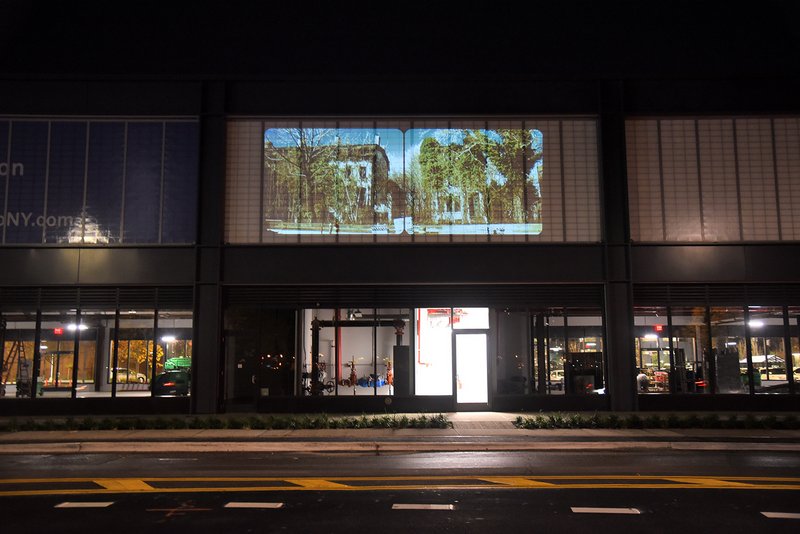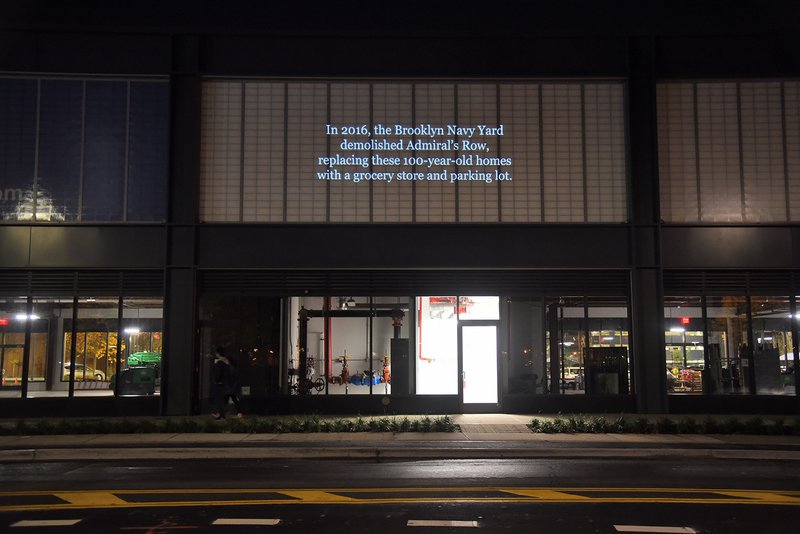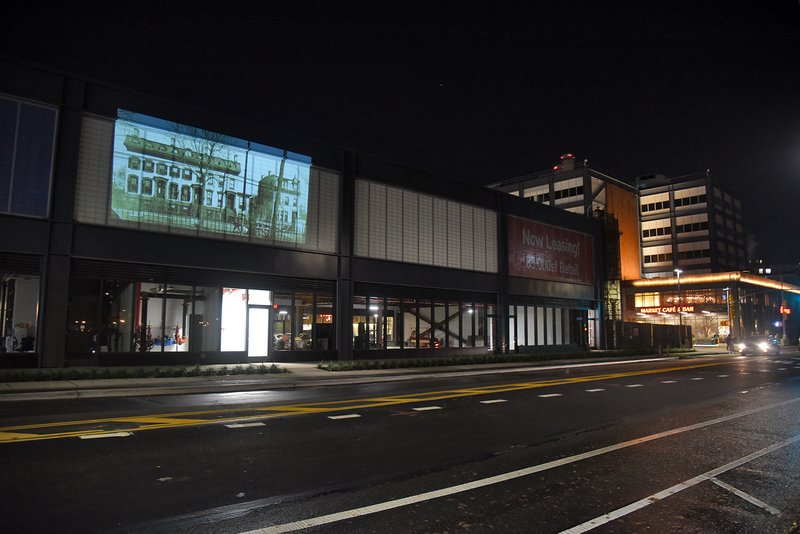Photographer and documentary filmmakers Nathan Kensinger and Nathan Dorr have been tracking the changes on New York City’s waterfront for the past fifteen years, producing a unique body of visual work and collaborative art initiatives that seek to make the resident an active participant in the sweeping transformations along the city’s natural boundaries. Their latest work projects a “memorial” onto the new Wegman’s grocery store at the Brooklyn Navy Yard, which was constructed on a site where the Admiral’s Row mansions once stood. The piece, “Admiral’s Row 1864 – 2016” is a video installation that projected exterior and interior photographs and footage of the mansions taken by Kensigner and Dorr since 2008.
 Photo courtesy Nathan Kensinger and Nathan Dorr
Photo courtesy Nathan Kensinger and Nathan Dorr
The second floor of Wegman’s became a perfect canvas for the art installation. Kensinger and Dorr told us, “We projected it on to the new buildings at the Brooklyn Navy Yard, exactly where the Row once stood, during the grand opening of Wegmans, as a sort of counter-narrative to all of the festivities and hype surrounding the supermarket. The installation asked viewers to stop and remember what was there before, and what was lost. A lot of people were happy to stop and talk about Admiral’s Row, which had been a part of that community for generations. The buildings may have been erased, but the community still remembers them.” The installation is part of an ongoing documentary project Kensinger and Dorr are working on that will eventually become a short film about the transformation of the landscape around Admiral’s Row.
The Brooklyn Navy Yard is undergoing a massive expansion plan, and the arrival of Wegman’s is another piece in the efforts to transform the former military installation into a place that can support jobs, offer a diversity of places to work, hire local residents, and provide amenities for the community. While there are certainly larger initiatives underway, including the recent opening of Dock 72 which is anchored by the beleaguered WeWork, or the expansion of Steiner Studios, the arrival of Wegman’s has possibly been the most divisive because of its location on the border between the neighborhood and the Navy Yard. The decision to demolish the Admiral’s Row houses (save for one) was made by the Army National Guard in 2009 against the protest of preservationists who believed the homes should be saved. This was followed by a request for proposal to develop the site. The plan to welcome a Wegman’s on Admiral’s Row was announced in May 2015, with the grocery store intended to be opened in 2017, which was delayed to 2019. The bulk of the demolition began on Admiral’s Row in 2016.
 Photo courtesy Nathan Kensinger and Nathan Dorr
Photo courtesy Nathan Kensinger and Nathan Dorr
Most of the media recently has focused on the almost cult-like following of Wegman’s and the excitement of New Yorkers to experience the popular grocery store that was founded in Rochester in 1916. But Kensiger and Dorr are reminding New Yorkers of what was lost to bring Wegman’s here: namely, ten historic homes that once housed Navy offices and their families. Preservationist had decried the impending demolition, which led to two buildings saved — though they are arguably the least interesting architecturally though the most conveniently sited. The images projected include Admiral’s Row in its abandoned state, as well as mid-demolition with cranes mid-air, crashing into the buildings, and historic photos.
 Photo courtesy Nathan Kensinger and Nathan Dorr
Photo courtesy Nathan Kensinger and Nathan Dorr
 Photo courtesy Nathan Kensinger and Nathan Dorr
Photo courtesy Nathan Kensinger and Nathan Dorr
You may have seen Kensinger and Dorr’s work in the documentary Managed Retreat, about post-Hurricane Sandy efforts to adapt to rising sea levels on Staten Island, participated in one of the many workshops Kensinger’s organization Chance Ecologies ran inside the last wild spaces before the new Hunters Point South Park was built. Though their work has a particular perspective, evident in how they describe their efforts in “photographing and filming all of the powerhouses, sugar refineries, and other historic structures that have vanished from the landscape, to be replaced by new glass towers,” theirs is not the cry of those that simply claim that New York City has lost the soul it once had. Kensinger and Dorr’s work presents, questions, and seeks innovative ways to help people remember what was lost and be more active participants in city change. There is certainly more development coming to the Brooklyn Navy Yard, and the documentary about Admiral’s Row will focus not only on its past, but also incorporate footage of the new buildings that were built.
Check out photos from Admiral’s Row in 2012.





